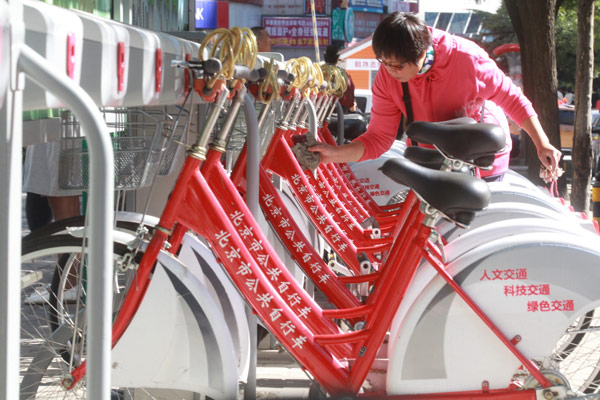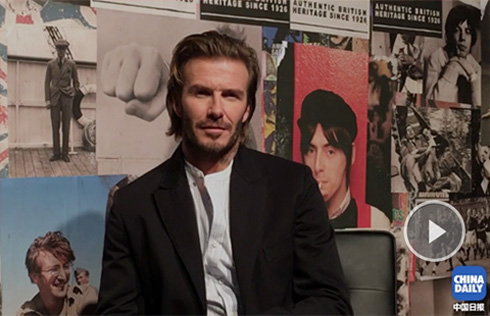Two wheels good, four wheels bad?
 |
|
People are being encouraged to get on their bikes in Beijing and other large Chinese cities. But the use of bike lanes by car drivers has caused unease among cyclists. Wang Jing / China Daily |
 |
|
A woman inspects bikes at a rental station in Beijing. Fu Ding / For China Daily |
Beijing is exploring methods of reducing traffic congestion by improving amenities for millions of cyclists to reduce dependency on the automobile, as Zhang Yuchen reports.
Zhao Liman grew up in China's "golden age" of the bicycle, during the 1970s and 80s, and has fond memories of cycling in a city packed with bikes.
From the age of 7, the native Beijinger was traversing her local hutong, the alleys that once dominated the center of the city, and cycling to school so she could squeeze in an extra 15 minutes of sleep. "My classmates and I would cycle wherever we went, either to the Fragrant Hills in autumn time or to the Summer Palace during the summer - about 30 km from downtown area where I lived," said Zhao. "We just had standard bikes at that time, without any of the special features you see on some bikes today."
After graduation, Zhao who is now in her 40s, lived overseas for 10 years. When she returned to the Chinese capital in 2006, she was astonished to see that "the roads were full of cars", so much so that Beijing was no longer a peddler's paradise.
However, both the municipal and central governments have indicated their determination to bring back the most people-friendly mode of transport as part of the city's development plan.
Earlier this year, Beijing Municipal Commission of Transport went public with its plan to regulate the city's network of 1,400 km of roads, after inspecting the condition of hundreds of cycle lanes and sidewalks and widening some of those in the busiest locations
Meanwhile, three government bodies - the Ministry of Finance, the National Development and Reform Commission and the Ministry of Housing and Urban-Rural Development - put forward a joint policy initiative in September, suggesting that by 2015, cities with a population of 10 million or more should encourage cycling and walking until they account for 45 percent of the traffic flow.
"The turnaround reflects public attitudes toward the sustainability of city development and 'green traffic'," said Zhao Jie, director of the Urban Transport Institute at the China Academy of Urban Planning & Design.
During the 2008 Beijing Olympics Games, a public bike rental project was started in the city. After showing ID and paying a deposit, residents were allowed to use a public bike for as long as they chose. However, despite a surge of popularity during the Games and the success of such initiatives in European cities such as Amsterdam, the project fell into abeyance post-Games as residents simply got back in their cars.
The municipal government is still making efforts to promote the system though, by opening it up to non-Beijingers. Since October, people without a Beijing hukou, or resident's permit, and foreigners residing in the city have been allowed to hire the brightly colored bikes, after payment of a deposit of 200 to 400 yuan ($32 to $64).
Short-distance shuttling
"We want to encourage residents to choose public transport and use bikes to shuttle between bus and subway stations. For short distances, cycling or walking are the only realistic methods of transport," said Zhao Jie.
Along with Mexico City, Beijing topped the list of the world's worst places for commuting, according to a 2011 survey of 20 cities, conducted by IBM. "Buses, subways, bikes and walking: The public transport system should be more widely used, rather than building more overpasses or widening the roads for cars," he said.
Currently, bikes account for about 16 percent of the traffic flow in Beijing, a decline from the 30 percent recorded in 2005. "If the percentage falls below 5, there won't be any way of rescuing the city," he added. "We can only say that Beijingers have a very good history of liking and riding bikes and all we need is to improve the facilities, awaken people's consciousness and regulate the rules for bike use."
In an attempt to reduce car use, the government introduced a "car-free" day in 2007. In the first year, 110 cities took part in the September event. This year, the number was 149.
In 2010, 32.5 percent of car journeys were shorter than 5 km, 1.5 percent more than in 2005, according to the Beijing 4th Comprehensive Transport Survey Summary Report in 2011.
The rise of the car
The humble bicycle was once the dominant mode of transport in Beijing, but the roadmap of what was once one of the world's best cities for cyclists has changed: "Some people choose not to ride a bike because of the urban traffic design, which is no longer suitable for cycling," said Zhao Liman.
As the number of cars on the capital's streets rose, motorists began using the city's dedicated bike lanes as parking lots, narrowing the room available and resulting in insecurity among cyclists.
"Exploiting the bike lanes is one of our top priorities," said Liu Changge, deputy director of Beijing Municipal Roadway Administration Bureau. Around 90 percent of the city's main roads have bike lanes, but there are few on secondary roads, according to a survey conducted by the bureau.
The bureau is now attempting to regulate motorists' use of bike lanes, arguing that such use should either be outlawed or limits should be imposed on the length of time people are allowed to park in them.
The quest for modernity
Zhao Liman remembers how agreeable the cycling environment was back in the 1980s, given Beijing's lack of hills and the tall polars that flanked the streets.
"No trip was regarded as too long, no destination seemed too far and I never seemed to feel tired," she recalled.
Now the streets are littered with rusting bikes and it seems as if Beijing has turned its back on the bicycle in its quest for modernity.
Qin Xuelong, who opened a bike sales and repair shop in the Haidian district in 2002, rued the decline of the bike. "The number of people riding bikes was huge in the 1990s, when I first arrived," he said. "But since 2004, it seems that the number has been falling."
"When I first stayed in China between 2004 and 2006, only 15 percent of people owned a car, while the other 85 percent wanted to own one," said Shannon Bufton, an Australian architect and a co-founder of Smarter Than Cars, an NGO that aims to promote cycling in Beijing.
"Public transport seldom meets the need of the residents and with the satisfaction people feel from car ownership, there's little chance that a more sustainable lifestyle will prevail," said Zhao Jie.
In 1997, one million Beijing residents owned a car. That number had risen to two million by 2003. In 2009, car owners numbered four million, and by early 2011, the number was five million.
Riding toward the future
Qin Xuelong, the bike repairer, said he has seen a rebound in the number of cyclists in the past two years: "The thing is, people are now buying more-expensive bikes and they go cycling in the suburbs," he said.
Bufton, who owns a bike cafe in addition to his work as an architect, has plenty of Chinese patrons who like to ride in the mountains for exercise but cycle to his cafe as recreation. "A lot of people visit the hutong for dinner. They see the bikes and think cycling is cool, so they drop in for a drink," he said. "It's time that the policy makers finally turned their attention to balancing the traffic flow in cities like Beijing," said Zhang Ying, an urban planner at a Beijing research institute. "Which means the city's primary construction has finished and the planners have started looking for ways to improve the downtown area."
"The ideal model should include a life-work balance. That is, the distance between home and work should be a 45-minute commute."
Experts such as Zhao Jie of the Urban Transport Institute, suggested that people should be encouraged to walk if their journey is 1 km or less, while bikes should be used for journeys up to 3 km, and should ride the bus of their journey is longer than 5 km.
After 10 years living and working in five different foreign cities and experiencing urban environments reliant on automobiles, Zhao Liman resisted buying a car when she returned to Beijing. She is passionate about the benefits of cycling as a smart solution to urban mobility problems. "I think the government should play a leading role in changing the mode of transport. Government efforts are key," she said.
Contact the writer at zhangyuchen@chinadaily.com.cn























